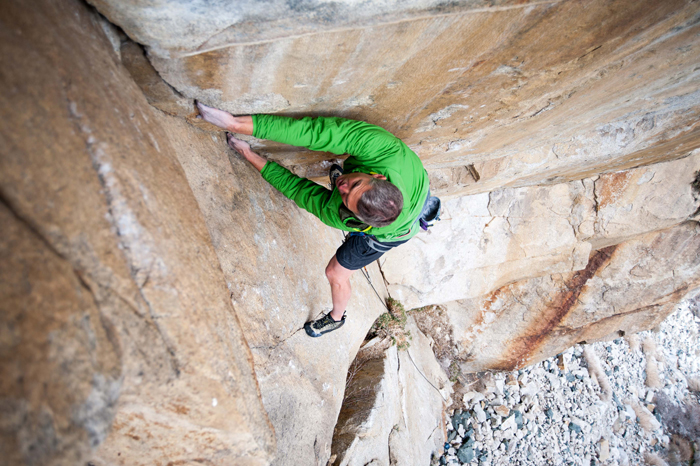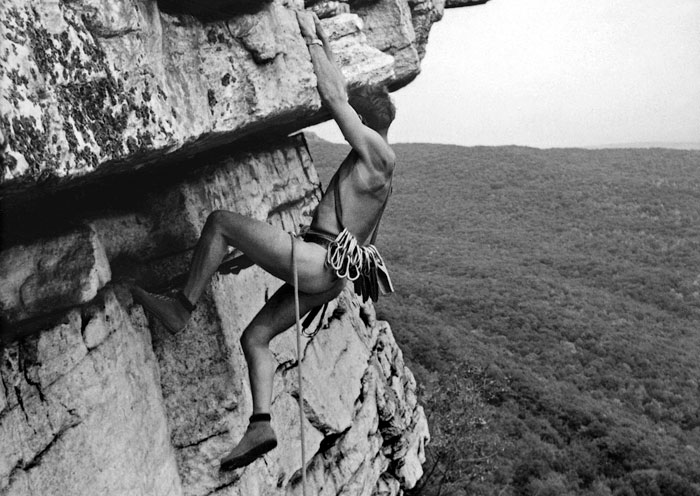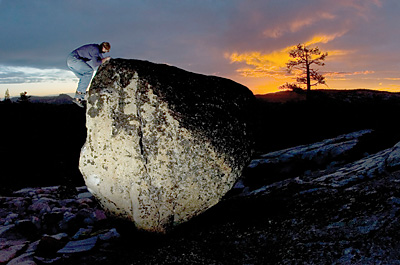- Tahoe’s Nevada Beach Tops the List of Hard-to-Book Campgrounds - 07/17/2024
- Cannabis Watershed Protection Program Cleans Up Illegal Grow Sites - 07/10/2024
- French Fire - 07/05/2024
Ron Kauk, Yosemite’s aging superhero, reflects on climbing, preservation, Hollywood and the National Park Service
By Robert Frohlich
When Ron Kauk fires up one of Yosemite’s big walls, his artistry cuts a swaggering figure. In an economy of motion, shoulder-length locks flapping, he gobbles up the granite with boundless energy. White granite begins turning yellow under a stained-glass sky. Flashing up finger and fist cracks, squeeze-chimneys and the slabs of the Valley’s monumental stone, Kauk finishes his route in the waning sunlight of a fall afternoon.
Climbing has never been a hobby to Kauk, but instead an unbridled passion, a lifeblood and personal code of environmental ethics. Yosemite National Park has been his home since age 16 when he put his wonder years aside, dropped out of high school in Redwood City and moved to the smooth and sheer vertical sweep of the Valley floor.
In 1974, his first summer in the Valley, he repeated the hardest free climbs of the day. He fell in with legendary climbers Yvon Chouinard and Royal Robbins, two icons mature enough to take the youth under their wing. Their influence didn’t stop with just climbing, but respecting the environmental aspects of the park. Nature and its harmony became his classroom.
Within a year he’d made significant steps that sent ripples throughout the climbing world. He completed the first free ascent of the Rostrum, an insane straight-up, slightly overhanging stone wall west of the Wawona Tunnel. He hooked up with legendary big wall climber Jim Bridwell to do Geek Towers next to Yosemite Falls then notched the first free ascent of the 1,200-foot vertical route Astroman on the east face of Washington Column.
As a member of the park’s Search and Rescue and mountaineering school, he lived freely for years in Yosemite’s nefarious, tawdry Camp 4 and set new standards for bouldering with first ascents on Midnight Lightening and Thriller, as well as on the short free climbs Tales of Power and Separate Reality.
New routes continued including two first ascents on Yosemite’s 3,000 vertical foot El Capitan and expeditions from Pakistan to Mali, Africa. For close to three decades, what he calls a ”decathalon of climbing” — whether ice or rock, big walls, speed climbs, or free solos (extremely dangerous climbs done without ropes or any sort of protection) — established him as a modern-day cape crusader to his peers and one of Yosemite’s, if not the world’s, most revered climbers.
The most remarkable thing about Kauk, though, is that behind his formidable resume is an innate soul that has allowed him to find not just serenity with nature, but an activism to protect it.
Horrified at the degradation of Yosemite’s precious Fern Spring near Pohono Bridge in the valley floor, Kauk wrote a proposal that earned a $15,000 grant from the Yosemite Fund to restore the spring.
“I’d found everything from bubble gum to bones in that water. All the surrounding ferns had been trampled. Visitors stop, not to admire the spring, but use it as an outhouse,” explained Kauk.
With the help of the grant and a commitment from the park system and native community to friends, Kauk restored plant life back. The small pool made from a series of waterfall steps became once again clear and pure enough to drink,
“All we need to do is protect and nurture. Our life source is water,” said Kauk, whose biggest notoriety came as the Hollywood stunt climbing double for Sylvester Stallone in “Cliffhanger” and Tom Cruise in “Mission Impossible ll.” “We hoped also that our efforts would help start a ripple effect to get more people to do even more.”
In 2003, Kauk published “Spirit of The Rock” (Gibbs Smith), a collection of observations of man and nature culled from his years spent hanging off rock. Two years later he and filmmaker Sterling Johnson produced “Return To Balance — A Climber’s Journey,” a 52-minute documentary that combined Kauk’s climbing with thoughts on the natural world and our collective responsibility to care for it. Now into his fifties, Ron lives in El Portal just outside his beloved national park.
On the first memory:
When I was 12, my step-dad took my brother and myself from our home in San Carlos to Yosemite. I looked up at El Cap and all the walls and it was a shocking reality. We climbed the ladder to the top of Half Dome. I loved peering over the edge – what a huge impression! Two years later I went on a 20-day backpacking trip through my high school. One of the adults was a climber. He’d brought a rope along and invited me to try a route. In fact he bet me a milkshake to do it. I made it up the climb. Every time I have a milkshake I think of that guy.
On the meaning of Yosemite:
I don’t mind saying that Yosemite is the most sacred place in the world. I look at everything here as alive. It’s an amazing web of life. Everything has its own place yet is all connected. My friend Jerry Moffatt says that Yosemite granite is the gods’ rock. When I first came to live here I truly believed that this place would take care of me and teach me to be happy and free. Back in 1997, the year of the big flood, things weren’t going that well for me. I’d broken my leg. I’d broken up with my girlfriend. Sponsors had discarded me. One day I reflected by the Merced River looking up at El Capitan. The valley view led me to a revelation. I began to feel very connected to a sense of place. I realized there was no separation between myself and this place. My eyes began to tear, not in sadness but happiness. I felt harmony. I knew I’d found my way home. Even the other day, feeling threatened while sitting in traffic, I filled the moment by looking to the river and feeling connected to all its beauty. Yosemite is always saying something and it never lets you down in the miracle of life.
On the National Park Service:
The NPS has every tool available to them – funding, the top scientists – they should be able to come up with what’s needed to balance human visits with preserving nature within Yosemite. That’s why it’s so disturbing to see a lack of spiritual awareness that politics play in the park. To think we can justify the constant killing of bears and mountain lions and the widening of roads. We need to heal and mend these wounds. Right now Yosemite can be compared to a theater selling 300 tickets when there are only 100 seats. It’s obvious there are way too many people driving into Yosemite Valley. The NPS and the people running this place have a responsibility to recognize Yosemite’s significance as a sacred place of nature, not a place for corporate or private interests.
On the future of Yosemite:
The actor Peter Coyote described it best when talking about the environment. He said we’re all like passengers on the Titanic. We know we’re headed for the iceberg but all we’re doing is rearranging the furniture on the deck. What has happened in Yosemite is shameful. Our air quality violates EPA smog standards. The roads are getting wider, traffic is speedier and there are more buildings being built. So much of it is connected to convenience, but it isn’t convenient for wildlife. The reality of bears being killed in the park says something is not right. If park policy allows for unlimited use there has to be a give and take. We’re simply taking too much.
On preservation:
I’m committed to protecting the earth. I recognize earth as a lifesource, and if nature is not kept healthy we’re not going to be healthy. There are higher laws that go beyond human laws and we should be educated to the sacredness of nature. It needs to be a conscious change, a rising vibe on everyone’s part. People who visit Yosemite should arrive willing to participate in its stewardship. It starts with oneself. I have good friends that work in the park service. I know what they’re up against. A friend of mine in park law enforcement says if people learn how to act in a library why can’t they know how to act when they go to a national park? I want to nurture relationships with the NPS. I want to promote more conversation, create trust and attain a mindset through education and awareness. I’m willing and motivated to work with people to help make Yosemite a place where people reconnect with nature.
On the state of climbing:
At times I think that SUV commercials say it all. The flood of media attention and commercialization has made the climbing world suffer. There are some significant things being done, but I think climbing’s deeper sense of self-discovery and the significance of the environment gets lost more and more because of our fast-paced society. So many people are climbing now. It can be too competitive. The climbing world should be balanced by challenge, respect and responsibility that freedom always demands.
On freedom:
Freedom defines the uniqueness of us all as individuals. It has so much to do with understanding our potential, of finding the simplicity to move in our own rhythm, to feel the harmony of mind and body. Freedom deals with the commitment to a spirit of adventure to just do your best. These rocks have been standing for thousands of years. The greatest climbers never really conquer anything. They only blend their spirit and the rock together. Climbing is a self-discovery thing. We need challenges to work with our senses and climbing has provided me a close look at nature and myself. That’s freedom.
On fear:
Climbing deals with not so much the sense of fear but the blending of it with the mind, body and spirit. I don’t think I’ve ever had fear, at least the paralyzing type. At the same time I’ve never thought of myself as a daredevil. I do everything to protect myself. I practice every fundamental and I train. I exercise – 100-finger tip pull-ups, dips, and train on my climbing wall I built behind my house – I’m kind of fanatic without being fanatic. I mean I really enjoy working out. I also keep an ear to my body. It keeps the ego in check. Sometimes you need to back off a route, whether because you need to prepare more or when your body tells you to go do something else, to go put energy into another rock. Rock is a funny thing – a monument to time that deals with creation that reflects one’s own state.
On aging:
Climbing is a way of life. It’s connected me to nature and the process of nature and its cycles. It’s not a lineal lifestyle. Like a seed you grow roots that go into the soil. The deeper you go the more appreciation you have of life and the harmony with the planet you can achieve. Part of aging is learning respect and humbleness and discovering that your spirit is not limited to just the body.
On being a professional climber:
For years I lived on a frugal existence of potatoes, peanut butter and honey. Whatever it took to survive and climb. I couldn’t be happier making a living through climbing. It’s no sell out. I’m proud to be an ambassador for Patagonia. Patagonia is committed to protecting the environment. They are very dedicated to many causes. I feel good about that.
On Hollywood:
Stallone was very humble. He had a lot of humor. At one point while learning a move, he said, “Give me a break, I get dizzy in a pair of high cowboy boots.” Cruise impressed me with his ability to emulate a climber’s moves. For such a mega star, he’s incredibly positive and contains a very friendly nature. David Lee Roth climbed up the ladder for an MTV video. He was so out of his lifestyle yet he got himself together to go over the edge. He enjoyed it so much that we ended up doing several more climbs. It’s always good getting together with people at the top of their game and discovering why they have such success.
On the spirit of the rock:
The natural world is our source of life. It has made me discover that there is a spirit to all things in nature. Climbing and the rock are incredible teachers about nature and the nature of us. Climbing puts me in balance with the natural world. It’s time for all of us to make a commitment to make earth a better place; to accept some sense of stewardship to preserve and protect the local areas in which we live. Both my film and book hopefully absorb the spirit of Yosemite and figure out ways to work with its community to improve environmental and social conditions. I’m hoping they inspire in everybody an increased respect for the earth and especially a spirit for the rock.”
Robert “Fro” Frohlich is a Tahoe-based journalist and author of two books on skiing in the Sierra Nevada.














